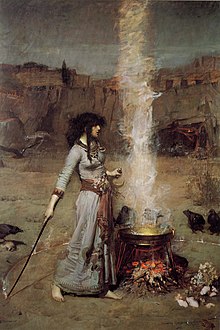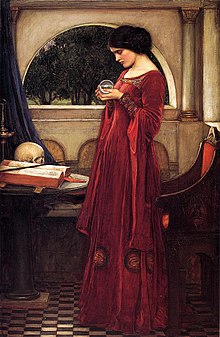Magic in fiction
This article has multiple issues. Please help improve it or discuss these issues on the talk page. (Learn how and when to remove these messages)
|
Magic in fiction is the endowing of characters or objects with powers unavailable in the real world.
Such magic often serves as a plot device and has long been a component of fiction, from the days of Homer and Apuleius, down through the tales of the Holy Grail and King Arthur to more contemporary authors such as J. R. R. Tolkien and C. S. Lewis, Ursula K. Le Guin, Robert Jordan, Terry Brooks, J.K. Rowling, Mercedes Lackey or Derek Landy.
Plot function
Within a work of fantasy, the function of magic is to move the plot forward, providing power for the hero of the story and/or power for those who oppose him/her. The use of magic frequently manifests itself in a transformation of the character, if not the world.[1]: 143
In order to carry out its function, magic often carries a price, equal to its value.[2]: 143 (See Fictional magic below.)
Historical beliefs

Historically, witches like the Weird Sisters in William Shakespeare's Macbeth and wizards such as Prospero in The Tempest or Doctor Faustus in Christopher Marlowe's play were widely considered to be real.[3]: 1027 However, modern writers and readers treat magic as imaginary.[3]: 1027
Fictional magic
Fictional magic may be inspired by non-fictional beliefs and practices, but may also be an invention of the writer.[citation needed] Even when the writer uses non-fictional beliefs and practices, the effect, strength, and rules of the magic will normally be what the writer requires for the plot.[citation needed] Fictional magic may or may not include a detailed magic system, but when the author does not bother to systematise the magic or create rules, it is more likely that magic will be used simply at the author's convenience, rather than as a believable plot element.[citation needed]
In any given fantasy magical system, the magical ability of the character is limited. Without limits, the story would have no conflict, and the influence of magic would eventually reach the "other side" (what we know as reality).[3]: 616 Fantasy writers use a variety of techniques to limit the amount of magic in a story,[4] such as limiting the amount of spells a character has,[4] restricting a character's magic through the use of an object,[4][5] limiting magic to the use of certain materials and making the materials hard to find,[6] and restricting the amount of magic a character can use due to the consequences of using it.[4]


Magic as an innate talent
In most fantasy works, writers tend to depict magic as an innate talent, equivalent to perfect pitch,[3]: 616 and there is wide variation on how spontaneously a person or other being with such a talent can use it.[citation needed] Talents that occur spontaneously usually need training in order to control their abilities.[citation needed] Those who use such spontaneously generated powers are usually not called magicians or similar terms, those being reserved usually for those who have to learn to wield magic.[citation needed]
Magic acquired through studying
Some works treat magic as a force that is acquired through studying books and tomes.[citation needed] Works which feature this concept usually include a school where magic is taught as a main setting.[citation needed]
Magic bestowed by another
Magic may also be gained by having it bestowed upon one by another,[citation needed] either through a pact with a devil or with other spirits, as is common in folklore.[7] In some cases, the demon may only provide the means for the would-be wizard to learn magic,[citation needed] or the pact may be for the devil to do the magic on the wizard's behalf, forcing the wizard to compel it to act.[citation needed] Sword and sorcery heroes are depicted as fighting against this type of wizard, along with crazed cults where gods or demons give power to their followers.[citation needed]
Magic via enchanted objects
In some works, such as fairy tales, magic items either endow the main characters with magical powers or have magical powers themselves, and are often used as plot devices or MacGuffins to drive the plot of a story.[8] Such items may be created by magicians or powerful beings, often in the distant past, but aren't possible to create at the present time of the story.[citation needed] Other fictional magical objects may have no explained past.[citation needed]
Wands and staves often feature in fantasy works, often in the hands of wizards.[9] Italian fairy tales put wands into the hands of the powerful fairies by the late Middle Ages[10] and the concept was transmitted to modern fantasy.[citation needed]
Magic divided into separate areas
In some works, types of magic are divided by colour.[11][citation needed] As in folkloric and occult tradition, the white and black magic dichotomy may also exist in these works.[citation needed]
Magic via words, names, or language
Some works feature magic that is performed through using words to cast spells.[citation needed] Many works use this method without offering an explanation for it while others do,[1]: 134 [2]: 167–168 with the explanation for it differing from one work to another.[citation needed]
Magical places
Some works feature magic that is tied to a certain area, such as an enchanted forest or an ancient battlefield.[citation needed] Such places are usually the homes of powerful magical beings.[citation needed] In these works, magic can only be accessed and performed in the area in question and runs out when all of the magic in the area is used up.[citation needed]
See also
- Magician (fantasy)
- Magic (Discworld), magic in Terry Pratchett's Discworld series.
- Magic (Earthsea), magic in the Earthsea series.
- Magic (Harry Potter), magic in the Harry Potter series.
- Magic in the works of J. R. R. Tolkien.
- One Power in the works of Robert Jordan.
- Master of the Five Magics in the works of Lyndon Hardy.
- Magic (gaming), magic in video and role-playing games.
- Kidō, magic in the Bleach anime and manga series.
- Magic in the Bartimaeus trilogy (Jonathan Stroud's series).
- Magic of Dungeons & Dragons
- The Will and the Word (The Belgariad)
References
- ^ a b Martin, Philip (2002). The Writer's Guide to Fantasy Literature: From Dragon's Lair to Hero's Quest: How to Write Fantasy Stories of Lasting Value (1st ed.). Waukesha, WI: Writer Books. ISBN 0-87116-195-8.
- ^ a b Attebery, Brian (1980). The Fantasy Tradition in American Literature: From Irving to Le Guin ([Reprod. en fac-sim.] ed.). Bloomington: Indiana University Press. ISBN 0-253-35665-2.
- ^ a b c d Clute, John; Grant, John; Ashley, Mike; Hartwell, David G.; Westfahl, Gary (1999). The Encyclopedia of Fantasy (1st St. Martin's Griffin ed.). New York: St. Martin's Griffin. ISBN 0-312-19869-8.
- ^ a b c d "The Limits of Magic". Victorianweb.org. Retrieved 2013-10-16.[dead link]
- ^ "2001: Accio Quote!, the largest archive of J.K. Rowling interviews on the web". Accio-quote.org. Retrieved 2013-10-16.
- ^ Card, Orson Scott (1990). How to Write Science Fiction and Fantasy (1st ed.). Cincinnati, Ohio: Writer's Digest Books. pp. 47–49. ISBN 0-89879-416-1.
- ^ Briggs, Katharine (1976). An Encyclopedia of Fairies: Hobgoblins, Brownies, Bogies, and Other Supernatural Creatures (1st Pantheon pbk ed.). New York: Pantheon Books. p. 279. ISBN 0-394-73467-X.
- ^ Thompson, Stith (1977). The Folktale ([Nouv. tirage] ed.). Berkeley: University of California Press. ISBN 9780520035379.
- ^ Frye, Northrop (1971). Anatomy of Criticism; Four Essays (2. print. ed.). Princeton: Princeton University Press. p. 152. ISBN 0-691-01298-9.
- ^ "Italian Fairies by Raffaella Benvenuto: Journal of Mythic Arts, Summer/Autumn, 2006, Endicott Studio". Endicott-studio.com. Archived from the original on November 3, 2012. Retrieved 2013-10-16.
{{cite web}}: Unknown parameter|deadurl=ignored (|url-status=suggested) (help) - ^ "Bonser, Wilfrid. "118. The Significance of Colour in Ancient and Mediaeval Magic: With Some Modern Comparisons." Man, vol. 25, 1925, pp. 194–198. www.jstor.org/stable/2840849". Bonser, Wilfrid. “118. The Significance of Colour in Ancient and Mediaeval Magic: With Some Modern Comparisons.” Man, vol. 25, 1925, pp. 194–198. www.jstor.org/stable/2840849.
External links
- Lawrence Watt-Evans, "Watt-Evans' Laws of Fantasy", Starlog
- Patricia C. Wrede, "Magic and Magicians", Fantasy Worldbuilding Questions
- Anders, C.J. (2011) "The Rules of Magic, According to the Greatest Fantasy Sagas of All Time" io9.com (includes 7x51 chart)
